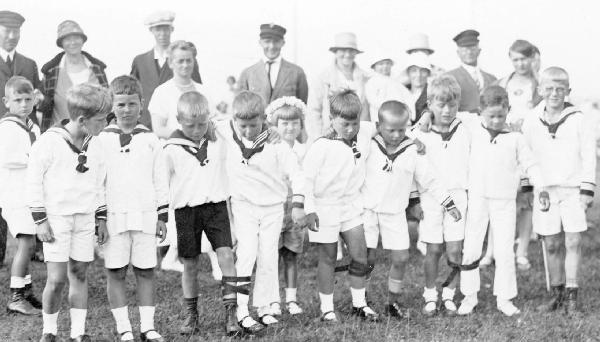
Outdoor Play and Games: Individual Picnic Games--Three Leged Race

Figure 1.--These German boys in 1927 have just had their legs tied to gether so they can participate in a three-legged race, probably at a picnic. All of the boys were wearing sailor suits. Click on the image to see the message on the back of the post card. On the back of this card it was written, "In memory of the children's festival in Kampen on the island of Sylt (Germany) in July 22nd, 1927". Sylt is an island, well known for tourism--especially rich tourists. Image courtesy of the MD collecion.
|
Three leged races were popular events at picnics and other festives events and parties. We believe that they were especially popular or picnics. Many HBC readers have probably run in three-leged races themslves. In fact they remain a popular picnic game to this day. They were not just for children, adult might also partivipate. Sometime here were several events that might include, for example, fathers and sons and mother and daughters. Usually there were separate races for the children as well. Three leged races envolved pairs of contestants in which their right and left legs were tied together. This required the contestants to coordinate their run in the race. We know these three-leged races were popular in America and Britain, but they also were popular in many countries on the continent such as Germany.
Image
We are not sure how to interpret the German image here. On the back of this card it was written, "Zur Erinnerung an das Kinderfest in Kampen auf Sylt (the same as a/Sylt) am 22. Juli 1927." This means "In memory of the children's festival in Kampen on the island of Sylt (Germany) in July 22nd, 1927". Sylt is a German island in the Baltic, well known for tourism--especially rich tourits. It apparently ws a popular spots for yachters. We thought Kampen might refer to a summer camp of some kind, but is the name of a town onthe island and has nothing to do with any kind of camp.
We thought at first that it was a picnic, but the adults are not dressed for a picnic. Note the peaked caps that the men wear. This might be a clue to the type of event this was. A German reader suggests that these caps look like "... a cap style worn by wealthy people with yachts, especially around Kiel. Kaiser Wilhelm II and his son Prinz Heinrich wore these caps." Boys also wore these caps which became known as "Prinz Heinrich Mütze".
The fact that all the boys wear white sailor suits is especially curious. Most German images show boys in the 1920s wearing a wide variety of outfits and not just sailor suits. Even boys wearing sailor suits tended to wear a much greater variey of sailor suits. Striped suitds for example were very common. Not only do these boys all wear shite middy blouses, but the collars are all the identical traditiional blue style with white stripes. (There is, however, some variation in the wrist cuff trim.) Other available images show German boys wearing quite a wide variety of middy blouse collar types. The similarity seen here is strongly suggested that they boys are wearing some sort of uniform or outfit coordinated by a group or organization of some nature. Also note that the boys do not have caps. The hair cut are also interesing. One boy has close-cropped hair. Before World War I, many of these boys would have had close croped hair cuts. A French reader suggests, "I suppose the reason why these boys were well dressed was that it was a fête and the boys were wearing their Sunday outfits."
HBC

Navigate the Boys' Historical Clothing Web Site:
[Return to the Main individual games page]
[Return to the Main picnic page]
[Introduction]
[Activities]
[Biographies]
[Chronology]
[Clothing styles]
[Countries]
[Literary]
[Bibliographies]
[Contributions]
[FAQs]
[Glossaries]
[Satellite sites]
[Tools]
[Boys' Clothing Home]
Navigate the Boys' Historical Clothing Web Site:
[Sailor suits]
[Sailor hats]
[Buster Brown suits]
[Eton suits]
[Rompers]
[Tunics]
[Smocks]
[Pinafores]
Created: March 3, 2003
Last updated: March 9, 2003



